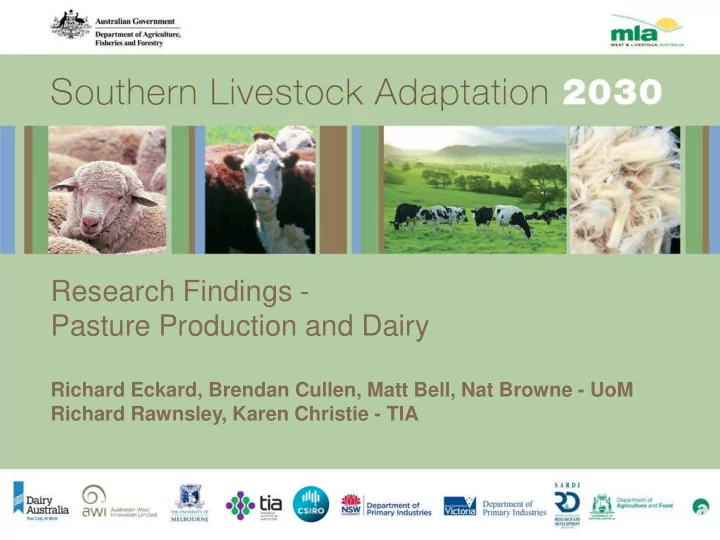

Research Findings - Pasture Production and Dairy Richard Eckard, Brendan Cullen, Matt Bell, Nat Browne - UoM Richard Rawnsley, Karen Christie - TIA
Toolkit • Whole Farm Systems models – DairyMod, SGS, GrassGro, APSIM • DSS tools – UDDER, DairyPredict, MIDAS, COST • GHG Accounting models – Dairy, Beef, Sheep, Crop GAF – DGAS, FarmGas • Downscaled climate data – Simple, CFT and CCS • People – Workshops – Model training
Warmer and drier future climates projected for southern Australia (A1FI) Will change the seasonal pattern of pasture growth 100 Pasture growth rate (kg DM/ha.day) Baseline 2030 climate 2070 climate 80 but a contraction of 60 the spring growing season 40 With higher pasture 20 growth rates in winter and early spring 0 Jan Feb Mar Apr May Jun Jul Aug Sep Oct Nov Dec Cullen et al (2009) Crop & Pasture Science , 60 , 933–942.
Resilience surfaces of pastures 2070 2050 2030 1971-2000 Drier Warmer Cullen et al. (2012). Crop and Pasture Science , 63:77-86.
Resilience surfaces of pastures 2070 2050 2030 1971-2000 Drier Warmer Cullen et al. (2012). Crop and Pasture Science , 63:77-86.
Resilience surfaces of pastures 2070 2050 2030 1971-2000 Drier Warmer Cullen et al. (2012). Crop and Pasture Science , 63:77-86.
Resilience surfaces of pastures • Total annual pasture production in southern Australia is generally resilient to climate changes of +1 ⁰ C with 10% less rainfall – but further changes are likely to reduce annual pasture growth • Responses differ at locations – Therefore adaptations will differ Drie r Warmer Cullen et al. (2012). Crop and Pasture Science , 63:77-86.
Should we consider Kikuyu in future? • Compare to ryegrass, Kikuyu has – Higher heat tolerance – Higher water use efficiency, deeper roots 14 Mean annual pasture production (t DM/ha) 12 10 Perennial 8 ryegrass/ 6 subclover 4 Kikuyu/ Subclover 2 0 0 1 2 3 Warming (°C) Bell et al. (2011) Modsim
Should we consider Kikuyu in future? 350 Elliott • Substantial warming is 300 ME yield (GJ/ha) still required before C 4 250 grasses will be more 200 150 productive than the 100 current C 3 species 50 0 0 1 2 350 Hamilton P ryegrass 300 ME yield (GJ/ha) Kikuyu 250 200 150 100 50 0 0 1 2 Warming ( o C) Bell et al. (2011) Modsim
Inter-annual and seasonal variability • Declining trend in pasture production • Variability currently high, but not outside the historical range 5 Sites across Victoria and Tasmania Bell et al. (2011) 2011 GSSA conference
Inter-annual and seasonal variability • 5 Sites across Victoria and Tasmania • Greater frequency of short spring 8 Short Long 7 Hamilton Frequency (yrs out of 10) 6 5 4 3 2 1 0 Bell et al. (2011) 2011 GSSA conference
Future change in autumn breaks and length of spring in NW Tasmania Long Spring Early Autumn Breaks 60% 60% 50% 50% Echam 40% 40% GFDL20 Percentage GFDL21 30% 30% Miroc Mk35 20% 20% Ukhad 10% 10% Mean 0% 0% 1971-2000 2001-2030 2031-2060 2061-2090 1971-2000 2001-2030 2031-2060 2061-2090 Christie et al. (2012) ASA conference
Breeding future pasture species 18 • Deeper rooting and 16 Pasture production (t DM/ha) heat traits will be 14 important 12 adaptations for pasture species in 10 future warmer and 8 drier climates 6 Baseline 2070 climate 2070 - deep roots 2070 - heat tol. 2070 - deep roots & heat tol. Cullen (2009) Crop and Pasture Science 60 , 933–942
Plant traits for future climates – using surrogates Perennial Ryegrass Phalaris • More resilient to lower rainfall • Susceptible to lower rainfall • Summer dormancy aids • Likely reduced persistence persistence Tall fescue • Advantage of Kikuyu • Deeper roots • More summer growth • Heat tolerance • More production if • Warmer and little rainfall change Cullen at al (2012) Climate Change
DGAS Calculator
Dairy greenhouse gas emissions • GHG emissions on >100 dairy farms using DGAS – ~1 kg CO 2 e/kg milk – Milk production/cow is key driver of GHG emissions intensity 60 Tasmanian farms 41 Australian farms 1.8 1.6 1.6 1.4 Milk GHG emissions intensity (kg CO2e/kg milk) Milk GHG emissions intensity (kg CO2e/kg milk) 1.4 1.2 1.2 1.0 1.0 0.8 0.8 0.6 0.6 0.4 0.4 0.2 0.2 0.0 0.0 0 10 20 30 40 50 60 0 5 10 15 20 25 30 35 40 Christie et al. (2011) Animal Feed Science and Technology 166-167 : 653-662
GHG emissions in future climates • N 2 O could 10 Kyabram increase in Terang Ellinbank N 2 O emissions (kg N/ha.year) southern 8 Elliott Australia 6 4 2 0 1971-2000 2030 High 2070 Med 2070 High Eckard & Cullen (2011) Animal Feed Science and Technology 166-167 : 736-748
Carbon Offsets Scenarios Tool (COST) • Mitigation options as potential CFI offsets • Financial viability of offset strategy • CFI income, implementation cost, productivity gain, total farm benefit
Implications • May not need to change species by 2050 – BUT • Seasonal distribution of growth will require adaptation • Plant breeding should start now – Temperature tolerance & deeper roots in C 3 grasses – Higher quality in C 4 grasses • Modelling recovery from extreme events – Current tools inadequate • On-farm N 2 O may increase in future climates – Mitigation modelling important – Strategies should also improve N efficiency
Recommend
More recommend